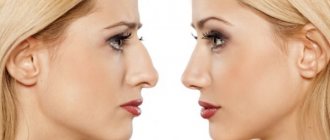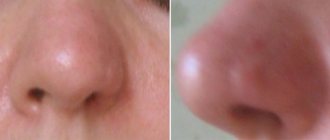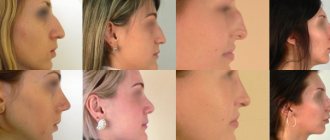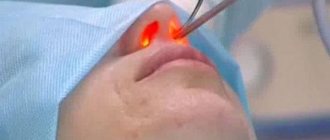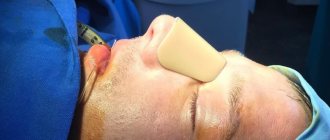- home
- Rhinoplasty
- Non-surgical rhinoplasty
Non-surgical rhinoplasty , or nose contouring, allows you to solve a number of aesthetic problems of the nose without resorting to traditional rhinoplasty. Non-surgical nose correction is becoming increasingly popular. And deservedly so. After all, this is an almost 100% guaranteed result, without the risk of anesthesia and surgery. With the help of non-surgical rhinoplasty, it is possible to correct the shape and size of the nose, instantly and permanently, and in some cases forever.
Indications for nose correction without surgery
Correction of asymmetry of the nasal bridge with injections of filler based on hyaluronic acid.
However, it should immediately be noted that the indications for nose correction without surgery are extremely narrow and must be strictly observed. The use of this technique is possible when the following problems exist:
- defects and deformations of the back and tip of the nose in the form of indentation, which can be easily corrected by non-surgical rhinoplasty;
- asymmetry of the back and/or tip of the nose, which, due to increased projection, can be corrected without surgery;
- insufficient projection of the tip of the nose;
- visible transition from the tip of the nose to the back.
- low bridge of the nose;
- Asian, African noses.
Non-surgical rhinoplasty can be used in a patient who has already had rhinoplasty as an alternative to revision rhinoplasty, when a minor correction is required, and the surgeon considers it inappropriate to perform a full-fledged operation, comparing the possible injury to the body from surgery and anesthesia with the existing defect. In this case, the surgeon can offer the patient contour plastic surgery of the nose, correcting existing defects with the help of a filler.
Non-surgical rhinoplasty can also be recommended to patients who are not sure about the need for surgery or are afraid of having it, or have not yet come to a clear understanding of how much they need rhinoplasty at all.
Rhinoplasty without surgery - myth or reality?
Home › Blog › Rhinoplasty without surgery – myth or reality?
Our clinic is so often asked to correct the shape or size of the nose without surgery, that we decided to dispel all myths and misconceptions on this topic.
LINLINE plastic surgeon Orlando Salas Moreno, a member of the Spanish Society of Plastic Surgeons, the Russian Society of Reconstructive, Plastic and Aesthetic Surgeons (OPRESH), and the European Society of Plastic Surgeons, helped to understand the problem.
Do you often get asked whether rhinoplasty is possible without surgery?
Yes, lately they have begun to ask this question much more often than before. I think the reason for this is unfair advertising on the part of plastic surgeons and clinics.
Many have realized that they can lure a client to a clinic for a consultation with promises of non-surgical correction, and then during the consultation convince them that this is simply “not their case” and they just need surgery.
And people think that plastic surgery has invented something new and incredible. Essentially, this is just a ploy. Some people react to it, some don't.
How do you answer this question?
I always say honestly that the very word “rhinoplasty” implies surgery. It is impossible to change the shape of the nose with injections. At the present stage of development of medicine, there is no other way to get a normal result.
I travel a lot to congresses, around the world, I know that there are no alternatives.
In what cases is injection nose correction possible? What can she fix?
You can temporarily introduce gels based on hyaluronic acid and get results for six months. This is filling the transition from the tip to the hump (hiding the “hard” transition).
You can also use injections if the bridge of the nose is deep: it can be made less deep. Botox only stops facial muscles and removes wrinkles on the bridge of the nose.
But if they write “injection change in the shape of the nose”, this is not entirely correct. Injections only visually “smooth out” some minor defects of the nose.
There is a hormone called “Diprospan” that destroys fat under the skin and destroys the cartilage of the tip of the nose and the septum. These are already serious changes, and indeed, with the help of injections of this drug you can change the shape. But this is a dangerous procedure, its result is unpredictable, and it is very difficult to correct the consequences later. It's no joke - destruction of cartilage! After all, it can be destroyed in the wrong place where it is needed, and the client will end up with a shape even worse than it was.
Diprospan injections are a therapeutic procedure; they are used if there is a tendency to fibrosis or poor scarring is observed. But using it in aesthetic surgery is a very big risk, and I am sure that it causes a lot of complications.
What problems can definitely be corrected only with surgery?
The nose is a complex structure; it has a septum, nasal sinuses, frontal sinuses - that is, a lot of structures. There may be enlarged turbinates, trauma to the nasal bones, and nasal polyps. There are combined situations: for example, a crooked partition + large sinks. Boxers often come with problems.
Any aesthetic changes are carefully discussed with the client. I draw on the computer, do modeling, a person can express his desires.
With the help of rhinoplasty, we also solve functional problems - then a CT scan of the nose is done, from which I can understand what is happening there with the structures of the nose.
Are these operations carried out simultaneously? How difficult is it?
Yes, of course, both aesthetic and functional problems are solved immediately, in one operation.
Regarding complexity: rhinoplasty is considered the most difficult operation in aesthetic surgery. It is complex from every angle, no matter where you look. Psychologically, physically, difficult and long healing period.
And there is one situation that does not depend on the surgeon, but determines the result - scarring. No surgeon can predict what the internal subcutaneous scar will be like after surgery. It takes a long time to form, over the course of a year, which means that a scarring defect may appear within a year. We warn about this, but people forget about it. And they begin to “attack” the surgeon on the Internet, although the surgeon did absolutely all the work correctly, but no one can predict the body’s reaction.
99% of such reviews are biased assessments. Many surgeons even refuse rhinoplasty due to bad reviews. About half. They don't do this operation, although they can!
Please share your good reviews after rhinoplasty.
Luckily I have a lot of them! I even take on operations that other surgeons refuse. Such clients are still grateful!
One day a girl came who had just turned 18 years old and she said - now I can get a nose job! Before this, everyone refused to undergo surgery because of their age. She had a complicated fracture when she was little. The nose was very crooked and she was constantly out of breath. The girl herself is very beautiful! She had lived without her parents since she was 15, and I noticed scars on her arms—she shared that she wanted to commit suicide. I asked why, she said because of the nose. It was difficult for her to wait, she went crazy because they teased her and made fun of her for having a strange nose.
We examined her, the situation was complicated: the bones were broken, there were serious calluses, the nasal turbinates were huge and hypertrophied. Everything that could be was gathered in one person. But she had hope, because many surgeons and clinics had already given up on her. We talked for a long time, and I was very worried about what would happen if she didn’t get the result she expected. But it turned out to be a great nose! She was very happy! Soon the girl got married. She is still delighted with her nose, and 10 years have passed. On her recommendation, they still come to me for rhinoplasty. Amazing story!
Orlando, do you perform surgeries that solve ONLY functional problems of the nose (without aesthetics)?
Yes, sure. It often happens that the nose is beautiful, but does not breathe. There are many noses that are crooked, but breathe perfectly. Rarely, but there is.
And I often meet people whose nose doesn’t breathe very well, but they think that everything is fine with their breathing. When you examine it before surgery, you understand that the nose has a functional problem. After the operation, everything returns to normal, and people are very surprised: the nose can breathe even better!
Is septoplasty (septum correction) possible without surgery?
No. But the operation to correct the septum is much simpler; it takes place without applying a cast, without bruises and without risks. An inconspicuous piercing of the tip of the nose is made. After 3 days, people around you will no longer understand that you had surgery. The operation is in great demand.
Prices
| Consultation with a plastic surgeon | 0 ₽ | Call |
go to blog
Popular posts
2015/02/24
RecoSMA: Dreams come true!
2016/01/21
Childhood without complexes. How to prevent scars from ruining a child’s life?
2017/12/04
Breast rejuvenation and lift
2016/05/20
Stretch marks: no longer forever
2016/08/16
All about the treatment of hyperhidrosis
In what cases is non-surgical rhinoplasty appropriate?
Non-surgical nose correction can be used both in the initial consultation of a patient who is not satisfied with the aesthetics of his nose, and for the correction of deformities after rhinoplasty has already been performed.
The most effective use of non-surgical rhinoplasty is for low nasal bridge. Excellent results are obtained when it is necessary to increase the projection of the nose, sharpen and lengthen its tip.
Non-surgical rhinoplasty photo: by resorting to non-surgical rhinoplasty, we were able to correct the obvious deformation of the patient’s nose, raise the bridge of the nose, and form a beautiful high profile of the bridge of the nose.
You can also achieve rotation (raising or lowering) of the tip of the nose, which is achieved by injecting filler into certain points. In addition, when performing non-surgical nose correction, not only fillers are used, but also botulinum toxin-containing drugs that allow you to influence the muscles of the nose and correct the direction of the trajectory of the tip of the nose. The method is also effective in correcting the nasolabial angle.
As we previously noted, a few years ago the main obstacle to the widespread development and use of contour rhinoplasty was the lack of fillers that would guarantee a stable result. Today, these fillers exist; moreover, they can be divided into temporary and permanent. At the same time, temporary fillers have a validity period from 6 months to 2 years. Permanent fillers include fat, but its use is extremely limited (there are practically no statistics on the use of fat during non-surgical rhinoplasty) and requires special knowledge, experience and indications from the surgeon.
Before and after photos: the patient came to the clinic in the hope that non-surgical rhinoplasty could solve the problems of his nose deformation. We managed to correct the consequences of an old fracture and straighten the bridge of the nose.
The most important thing that can be highlighted as a guarantee of achieving a good result is the experience of the surgeon performing non-surgical rhinoplasty, who must master traditional methods of surgical rhinoplasty, allowing him to feel and understand well both the internal structures of the nose and its external aesthetics and methods of correcting nasal deformities, as well as knowledge of the range of fillers on the market that are suitable for use in nasal contouring and the technique of their administration.
Thus, non-surgical rhinoplasty is a powerful, safe and guaranteed way to correct a number of nasal deformities, which depends on the experience and knowledge of the surgeon. This procedure is suitable for both very busy people and men who do not have time for long-term rehabilitation after traditional rhinoplasty. You see the results of nose contouring almost immediately, already the next day, when the swelling from the procedure goes away.
Effect of diprospan in rhinoplasty:
- anti-inflammatory;
- antiallergic (eliminates allergic and dermatological diseases);
- anti-shock;
- decongestant (helps reduce soft tissue swelling);
- prevents the formation of granulation and scar tissue;
- eliminates defects in the form of postoperative scars.
Of course, this drug also has contraindications. A doctor's consultation is required. Also, the plastic surgeon must be able to work with this drug and correctly determine the dosage. Use only in hospital. Do not try to repeat this yourself at home or with any cosmetologist at home or in the office of a beauty salon. Only the surgeon operating on you with the appropriate training should perform the injection. Many negative reviews about this drug are due precisely to its improper use - holes, unevenness, potholes on the nose, tissue atrophy, etc.
You need to understand that even the use of diprospan will not completely relieve you of swelling in a few days. This takes time. The patient can see the final result of rhinoplasty within a year. In some cases - after a year and a half.
Prices for non-surgical rhinoplasty
The cost of non-surgical rhinoplasty depends on the volume and nature of the required correction. After making a diagnosis, the surgeon selects a filler, the price of which will ultimately largely affect the final cost of the procedure.
Non-surgical rhinoplasty price in Moscow
| Operation name | Cost in rubles |
| Nose correction using an injectable implant | 50000 |
See all prices
Popular questions about rhinoplasty (nose job) at the Doctor Grishkyan clinic in Moscow
What is rhinoplasty? Rhinoplasty is a surgical operation aimed at correcting the shape of the nose. Rhinoplasty occupies a leading position in popularity. It allows you to correct the shape of your nose and make it more elegant.
What are the indications for rhinoplasty?
Indications for rhinoplasty are deformities in the nasal area and difficulty breathing. Usually these are external congenital or acquired features of the shape of the nose (nose length, width, hump, etc.)
Attention: it is necessary to cleanse the face a week before surgery to prevent inflammatory elements in the area where the cast is installed.
Watch all videos
Where will the incision be made, will the scar be visible?
The skin part of the nasal septum is incised at its narrowest section. After 2-3 weeks, the scar is almost invisible, or the operation can be performed using a “closed” approach.
What is the difference between open and closed rhinoplasty.
Rhinoplasty can be done in two ways: open and closed. With the open method, a small incision is made on the septum between the nostrils. The skin and mucous membranes are removed, and all required manipulations are performed. This method is the simplest. It provides a complete overview during surgery and a wider area of influence on bone and cartilage tissue.
What kind of anesthesia is used?
The operation is performed under general anesthesia with the addition of local anesthesia
What is the duration of the operation and anesthesia for nose surgery?
The operation is performed under general anesthesia. Duration ranges from 30 minutes to 2-6 hours, depending on the complexity and method of implementation.
Where can I see the results of your rhinoplasty work?
Go to photo gallery
Is it necessary to stay in the clinic after surgery and for how many days?
After the operation, you must stay in the hospital for the first two days. Immediately after surgery, the nasal passages are sealed, making it difficult to breathe freely through the nose. A plaster modeling bandage is applied to the nose to fix the tissues in a new position for 5-7 days.
How long will the bruising and swelling last?
As a rule, the swelling is not significant and increases by the third day after surgery, which may manifest itself as nasal congestion. There may be swelling in the eye area. Slight swelling of the tissues outside the nose can last up to 3-4 weeks, which is usually not noticeable to others. Bruises in the area of the bridge of the nose and in the eye area occur in a number of cases, depending on the extent of the operation, but do not last long. With the help of special procedures prescribed by the doctor, bruises disappear, as a rule, 10-14 days after surgery.
How often do dressings need to be done and when are the stitches removed?
The next morning after the operation, you will undergo the first dressing and remove the turundas from the nasal passages. It is necessary to carry out dressings and examinations on the third and fifth days. On the seventh day after surgery, the stitches and plastic bandage from the back of your nose will be removed.
Will your nose hurt after surgery?
Minor pain is possible on the first day after surgery. Due to the swelling that increases over three days, there may be a bursting feeling in the nose area
How quickly can the effect of the operation be assessed?
Preliminary results of the operation can be assessed in 2 months, final results in half a year.
What to do in the postoperative period at home?
Don't blow your nose. If necessary, you can clean the nasal passages with cotton swabs, very carefully. If your nose is leaking, blot it with a napkin, without sudden movements. The bandage on the nose should fix the tissue for up to 7 days and can only be removed by a doctor. Do not touch, move or get it wet. Do not eat hard foods that require prolonged chewing. Avoid prolonged physical activity. Brush your teeth with a soft toothbrush, avoiding trauma to your upper lip and nose. When washing your face and hair, avoid getting the bandage wet. Avoid direct sunlight for 6 weeks.
Choose clothes that are easy to put on. Avoid wearing items with narrow necks, such as turtlenecks and sweaters. Don't swim for a month. Do not take procedures or medications without consulting your doctor. Do not wear glasses that rest on the bridge of your nose. If this is not possible, contact your doctor.
Wearing contact lenses may cause discomfort; it is advisable to refrain from wearing them for 2-3 days. After removing the plastic bandage from the nose, the skin in the area should be treated with medium-fat creams. Cosmetics can be used immediately after the bandage is removed. You can disguise bruises with decorative cosmetics. After the operation, tactile and temperature sensitivity of the nose will be reduced. Avoid hypothermia in winter.
Is the suture removal procedure painful?
Almost painless.
What are the complications after surgery?
Over the course of six months or a year, the nose periodically swells - due to changes in pressure, the liquid you drank the day before, it turns red in the cold, you need to wait patiently until the situation normalizes.
Is it possible to wash your hair after surgery?
It is important not to wet the bandage or stitches. If absolutely necessary, you can wash your hair at the hairdresser (with your head thrown back).
When can you put on makeup or use cosmetics?
Makeup and cosmetics can be used immediately after removing the modeling bandage, avoiding massage, pressure, and sudden movements in the nose area.
Is it possible to sunbathe and after what time?
To avoid active pigmentation in the intervention area, sunbathing for a month is not recommended.
Is physical therapy necessary for faster healing?
Doctors at our clinic prescribe physiotherapeutic procedures on the 5th day after surgery, aimed at relieving swelling and bruising.
How much does a nose job cost at your clinic?
Rhinoplasty (nose job) cost of surgery
| Operation name | Cost in rubles |
| Total rhinoplasty | 350000 300 000 |
| Repeat rhinoplasty (nose job after rhinoplasty by another surgeon) | 400000 |
| Rhinoplasty of the tip of the nose | 230000 |
| Septoplasty (ENT surgery to correct the nasal septum) | 150000 |
| Plastic surgery of the nasal bridge with removal of the hump | 230000 |
| Elimination of deformation of the wings of the nose | 50000 |
Non-surgical rhinoplasty price in Moscow
| Operation name | Cost in rubles |
| Nose correction using an injectable implant | 50000 |
Diprospan injection after rhinoplasty
During the procedure, the specialist injects into the problem area of the nose using a thin needle. There may be some pain during the procedure. All this depends on the period after rhinoplasty. The shorter the period, the less sensitivity. In the early stages, sensitivity has not yet been restored and you may feel some numbness in the nose, and therefore, the pain is much less than at a time closer to a year after the operation.
After the injection, your nose may become swollen. The swelling usually goes away within a day. The drug has a long-lasting effect and is present in the treated area for several months. The positive effect of the drug begins 3-5 days after the injection. Diprospan acts only on soft tissue in the injection area and has no effect on the body.
General recommendations after a diprospan injection:
- do not apply decorative cosmetics to the area of application of diprospan for a day;
- on the same day it is forbidden to be exposed to UV rays;
- do not get hypothermic, if the injection occurred in winter, it is better to cover your nose after the injection outside with a scarf;
- saunas, steam baths, hot baths are naturally prohibited for a day;
- Avoid sports and increased physical activity for at least a day after the injection;
- do not rub the injection area.
The number of injections is individual in each case and is prescribed by the doctor. You should not ignore the surgeon’s recommendations for prescribing a diprospan injection. The injection can help resolve complications that arise in the early stages.
© PlasticRussia, 2022. All rights reserved. Full or partial copying of site materials without the consent of the portal administration is prohibited.
0
What else would you like to know?
How long swelling lasts after rhinoplasty is an individual indicator. It is most often impossible to determine exact terms, only averages. Even if the decline in swelling is a little delayed and does not correspond to what the surgeon said, this is normal and there is no need to worry. Remember that recovery depends on many factors (age, complexity of the operation, skin density and much more).
But if pronounced swelling lasts for a very long time, and is also accompanied by problems such as tissue compaction, pain, nasal discharge (purulent or bloody), increased body temperature, and the like, this is a sufficient reason to immediately contact your specialist and talk about these symptoms. Rhinoplasty is a complex operation, and although the skill of the surgeon and a good clinic help reduce the risks of complications to a minimum, such consequences cannot be excluded at all. Therefore, in case of the slightest doubt, it is advisable to consult your operating surgeon.
How to speed up healing
How much the nose swells after rhinoplasty is a very individual question. Recovery takes a different time for each patient. But it is still possible to help your body and stimulate speedy healing. To do this, you must follow the following rules:
- do not visit the bathhouse, sauna,
- do not take hot baths,
- do not tilt your head or body forward,
- limit physical activity,
- give up alcohol and cigarettes,
- sleep half-sitting.
High temperatures, as well as bending the body forward, promote blood flow to tissues, including injured ones, which negatively affects healing. In addition to avoiding thermal procedures, you can additionally help yourself by applying cold compresses to the operated area.
These recommendations and prohibitions do not apply for the rest of your life, but only for the first weeks after surgery. Following these rules will help speed up regeneration and reduce the number of days it takes for swelling to subside after rhinoplasty.
The operation is suitable for both women and men.

